
The Gay Divorcee is a 1934 American musical romantic comedy film directed by Mark Sandrich and starring Fred Astaire and Ginger Rogers. It also features Alice Brady, Edward Everett Horton, Erik Rhodes, and Eric Blore. The screenplay was written by George Marion Jr., Dorothy Yost, and Edward Kaufman. It is based on the Broadway musical Gay Divorce, written by Dwight Taylor, with Kenneth Webb and Samuel Hoffenstein adapting an unproduced play by J. Hartley Manners.
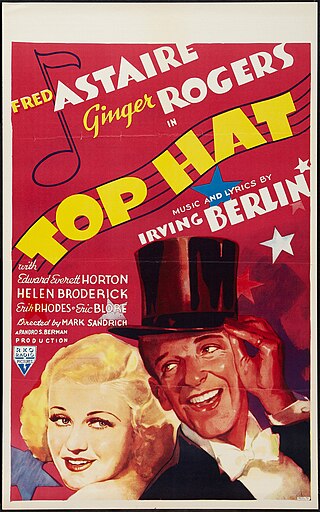
Top Hat is a 1935 American musical screwball comedy film, in which Fred Astaire plays an American tap dancer named Jerry Travers, who arrives in London to star in a show produced by Horace Hardwick. He meets and attempts to impress Dale Tremont to win her affection. The film also features Eric Blore as Hardwick's valet Bates, Erik Rhodes as Alberto Beddini, a fashion designer and rival for Dale's affections, and Helen Broderick as Hardwick's long-suffering wife Madge.

Ginger Rogers was an American actress, dancer and singer during the Golden Age of Hollywood. She won an Academy Award for Best Actress for her starring role in Kitty Foyle (1940), and performed during the 1930s in RKO's musical films with Fred Astaire. Her career continued on stage, radio and television throughout much of the 20th century.

Fred Astaire was an American dancer, actor, singer, musician, choreographer, and presenter, whose career in stage, film, and television spanned 76 years. He is widely regarded as the "greatest popular-music dancer of all time" He received an Honorary Academy Award, a BAFTA Award, three Emmy Awards, two Golden Globe Awards, and a Grammy Award.

Easter Parade is a 1948 American Technicolor musical film directed by Charles Walters, written by Sidney Sheldon, Frances Goodrich, and Albert Hackett from a story by Goodrich and Hackett, and starring Judy Garland, Fred Astaire, Peter Lawford, and Ann Miller. The film contains some of Astaire's and Garland's best-known songs, including "Easter Parade", "Steppin' Out with My Baby", and "We're a Couple of Swells", all by Irving Berlin.

Swing Time is a 1936 American musical comedy film, the sixth of ten starring Fred Astaire and Ginger Rogers. Directed by George Stevens for RKO, it features Helen Broderick, Victor Moore, Betty Furness, Eric Blore and Georges Metaxa, with music by Jerome Kern and lyrics by Dorothy Fields. Set mainly in New York City, the film follows a gambler and dancer, "Lucky" (Astaire), who is trying to raise money to secure his marriage when he meets a dance instructor, Penny (Rogers), and begins dancing with her; the two soon fall in love and are forced to reconcile their feelings.

Broadway Melody of 1940 is a 1940 MGM film musical starring Fred Astaire, Eleanor Powell and George Murphy. It was directed by Norman Taurog and features music by Cole Porter, including "Begin the Beguine".
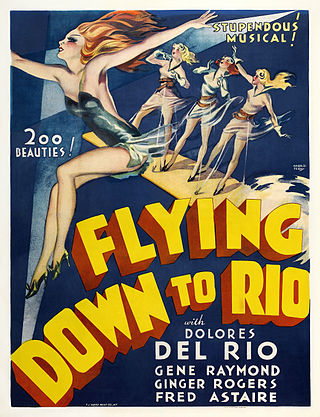
Flying Down to Rio is a 1933 American pre-Code musical film famous for being the first screen pairing of Fred Astaire and Ginger Rogers, although lead actors Dolores del Río and Gene Raymond received top billing. Among the featured players are Franklin Pangborn and Eric Blore. The songs in the film were written by Vincent Youmans (music), Gus Kahn and Edward Eliscu (lyrics), with musical direction and additional music by Max Steiner. During the 7th Academy Awards, the film was nominated for the new category of Best Original Song for "Carioca", but it lost to "The Continental" from The Gay Divorcee, the next Astaire and Rogers film.
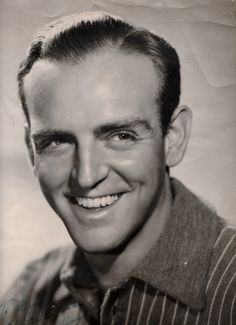
Hermes Pan was an American dancer and choreographer, principally remembered as Fred Astaire's choreographic collaborator on the famous 1930s movie musicals starring Astaire and Ginger Rogers. He worked on nearly two dozen films and TV shows with Astaire. He won both an Oscar and an Emmy for his dance direction.
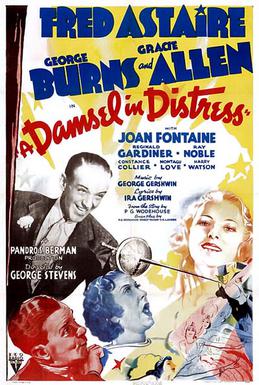
A Damsel in Distress is a 1937 American English-themed Hollywood musical comedy film starring Fred Astaire, George Burns, Gracie Allen and Joan Fontaine. Loosely based upon P.G. Wodehouse's 1919 novel of the same name and the 1928 stage play written by Wodehouse and Ian Hay, it has music and lyrics by George and Ira Gershwin. The film was directed by George Stevens, who had also directed Astaire in Swing Time (1936).

Follow the Fleet is a 1936 American musical comedy film with a nautical theme starring Fred Astaire and Ginger Rogers in their fifth collaboration as dance partners. It also features Randolph Scott, Harriet Hilliard, and Astrid Allwyn, with music and lyrics by Irving Berlin. Lucille Ball and Betty Grable also appear, in supporting roles. The film was directed by Mark Sandrich with script by Allan Scott and Dwight Taylor based on the 1922 play Shore Leave by Hubert Osborne.

Three Little Words is a 1950 American musical film biography of the Tin Pan Alley songwriting partnership of Kalmar and Ruby. It stars Fred Astaire as lyricist Bert Kalmar and Red Skelton as composer Harry Ruby, along with Vera-Ellen and Arlene Dahl as their wives, with Debbie Reynolds in a small but notable role as singer Helen Kane and Gloria DeHaven as her own mother, Mrs. Carter DeHaven.
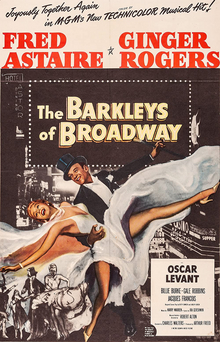
The Barkleys of Broadway is a 1949 American Technicolor musical comedy film from the Arthur Freed unit at Metro-Goldwyn-Mayer that reunited Fred Astaire and Ginger Rogers after ten years apart. Directed by Charles Walters, the screenplay is by Betty Comden, Adolph Green, and Sidney Sheldon, the songs are by Harry Warren (music) and Ira Gershwin (lyrics) with the addition of "They Can't Take That Away from Me" by George and Ira Gershwin, and the choreography was created by Robert Alton and Hermes Pan. Also featured in the cast were Oscar Levant, Billie Burke, Jacques François and Gale Robbins. It is the last film that Astaire and Rogers made together, and their only film together in color. Rogers came in as a last-minute replacement for Judy Garland, whose frequent absences due to a dependence on prescription medication cost her the role.

Shall We Dance is a 1937 American musical comedy film directed by Mark Sandrich. It is the seventh of the ten Fred Astaire-Ginger Rogers films. The story follows an American ballet dancer (Astaire) who falls in love with a tap dancer (Rogers); the tabloid press concocts a story of their marriage, after which life imitates art. George Gershwin wrote the symphonic underscore and Ira Gershwin the lyrics, for their second Hollywood musical.

Roberta is a 1935 American musical film released by RKO Radio Pictures and directed by William A. Seiter. It stars Irene Dunne, Fred Astaire, Ginger Rogers, and features Randolph Scott, Helen Westley, Victor Varconi and Claire Dodd. The film was an adaptation of the 1933 Broadway musical Roberta, which in turn was based on the novel Gowns by Roberta by Alice Duer Miller. It was a solid hit, showing a net profit of more than three-quarters of a million dollars.

Tom, Dick and Harry is a 1941 American comedy film directed by Garson Kanin and starring Ginger Rogers, George Murphy, Alan Marshal, Phil Silvers, and Burgess Meredith. It was produced and released by RKO Radio Pictures. The screen play written by Paul Jarrico, Rogers was working on the film when she was awarded the Oscar as Best Actress for her 1940 performance in Kitty Foyle. It was her first film released after her Oscar win. It was remade as The Girl Most Likely (1957), a musical which was also the last film released by RKO.
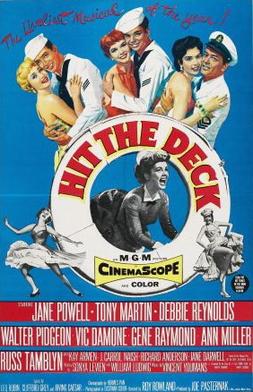
Hit the Deck is a 1955 American musical film directed by Roy Rowland and starring Jane Powell, Tony Martin, Debbie Reynolds, Walter Pidgeon, Vic Damone, Gene Raymond, Ann Miller, and Russ Tamblyn. It is based on the 1927 stage musical of the same name – which was itself based on the hit 1922 play Shore Leave by Hubert Osborne – and was shot in CinemaScope. Although the film featured some songs from the stage musical, the plot was different. Standards featured in the film include "Sometimes I'm Happy", "I Know that You Know", and "Hallelujah".

Fred Astaire and Ginger Rogers were dance partners in a total of 10 films, 9 being released by RKO Pictures from 1933 to 1939, and 1, The Barkleys of Broadway, by Metro-Goldwyn-Mayer in 1949, their only Technicolor film.

In Person is a 1935 American romantic musical comedy film directed by William A. Seiter and starring Ginger Rogers, George Brent and Alan Mowbray.
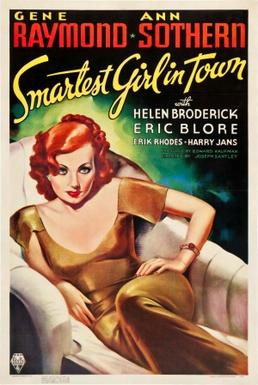
Smartest Girl in Town is a 1936 American comedy film directed by Joseph Santley, written by Viola Brothers Shore, and starring Gene Raymond, Ann Sothern, Helen Broderick, Eric Blore, Erik Rhodes and Harry Jans. It was released on November 27, 1936, by RKO Pictures.




















